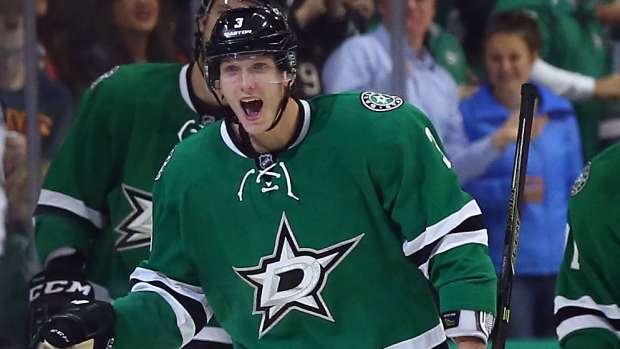Dec 20, 2016
Dallas has big problems on defence
Alex Goligoski was one of three veteran defenders that the Dallas Stars lost in the 2016 offseason. The club bet heavily on blueliner John Klingberg’s ability to shoulder a bigger workload but it’s been a struggle so far this season, Travis Yost writes.
By Travis Yost

One of the toughest jobs for the modern-era hockey coach is knowing just how much you can squeeze out of a certain player or unit before they reach their physical limit. The NHL’s competitive landscape – and the constraints of a hard-cap league – has made this a mandatory exercise for every hockey operations department, and the teams that travel the furthest are the ones that seem to have internal player evaluation down to a science.
I’ve long argued that this is an emphatically more difficult exercise when it comes to defencemen because the position lends itself to incredible complexity. For forwards, the name of the game (for most players) is to light the lamp, and that’s easily captured in regular goals/assists counting statistics.
Points can be hard to come by for defenders. Not every blueliner is whirling around the offensive zone like Erik Karlsson or Brent Burns, so you have to be able to gauge how much of an impact a blueliner is having on his teammates’ performance and on his team’s goal differential. Modern statistics can help navigate some of these unknowns, but little is guaranteed.
I think one of the best examples of this is what’s happening in Dallas – another Western Conference team that’s taken a big step backward from last season. Like many teams out there, the story hasn’t being driven by emphatic off-season turnover and/or the purging of a coaching staff. The Stars returned most of their roster, but have watched results degrade over the first 30-or-so games of the season.
While much remained unchanged in Dallas, the team did transition some players on the blueline. They let Kris Russell walk after what can only be considered a failure of a rental, and gave up Jyrki Jokipakka to acquire him. They also let big-minute mainstay Alex Goligoski walk, and, to some degree, tried to offset him with the signing of Vancouver’s Dan Hamhuis.
The biggest bet was on John Klingberg. There’s no doubt that Dallas felt okay letting Goligoski walk with how strong Klingberg had looked in his first two NHL seasons. Goligoski became a cap casualty and Klingberg, the thinking went, would evolve into the team’s big-minute defender.
Hindsight is 20/20, but it sure seems as though the bet on Klingberg to absorb so much incremental workload has been a risky one. One of the things that made Dallas so competitive last year – outside from very productive forward lines – was the fact that their defensive pairings were acceptable, if not reliable. The pairing of Goligoski/Klingberg in particular played bulk minutes with the team’s top line, and as a five-man unit, they were pretty darn tough to stop.
Klingberg not only lost a talented partner, he’s also been asked to carry a pairing that features 22-year-old rookie Esa Lindell. It’s a far cry from where this team was a year ago, and when together with Lindell, the Stars have struggled.
In a lot of ways it’s a microcosm of the regression we have observed. Let’s just look at key performance metrics from Klingberg pairings over the last two seasons to illustrate this – last year with Goligoski, and this year with Lindell. (Data via Corsica)

That’s a pretty substantial step back for a team’s top pairing. We know Dallas in general has regressed year-over-year, so maybe the Klingberg pairing of 2016 is still the team’s best pairing, even with extremely mediocre numbers. Is that true?
Here are the team relative numbers for the same exact timeframe:

Are these numbers bad enough to get sent to the press box? Certainly not. But they are also a far cry from where Dallas’ top pairing was just six months or so ago. These issues become more prominent for top-heavy teams – the Stars last year were reliant on their best five-man unit being virtually unstoppable, and it smoothed over a lot of the holes on the roster.
Now their first pairing looks incredibly ordinary. They’re actually getting a weaker percentage of the shots than the team’s second and third pairings, which is a massive red flag. The scoring chances and goal numbers are also sitting just a shade above break-even, which might be good enough for a second-pairing duo, but not really the exclamation point general manager Jim Nill and head coach Lindy Ruff are looking for from guys who are logging a ton of minutes.
This, more than anything, is what the Stars need to figure out. Tyler Seguin and Jamie Benn are still as dynamic as ever, and it seems to me that what ails this team more than anything is an inability to win the day when their toughs are out on the ice for 20 minutes a night. I’m not sure how much blame you can apportion Klingberg for that, but it’s not nothing – he’s not as effective as he was last year, and it’s hurting them in the standings.
I’m still very optimistic about Klingberg and what he can do for this Dallas team. I would have committed to him long-term in the same manner the Stars did last summer. But I do think we are at a point where you can ask if there are better solutions than what the Stars are currently pushing forward. Perhaps it starts with mixing up the defensive pairings a bit to see if that’s a formula that ignites this team.

